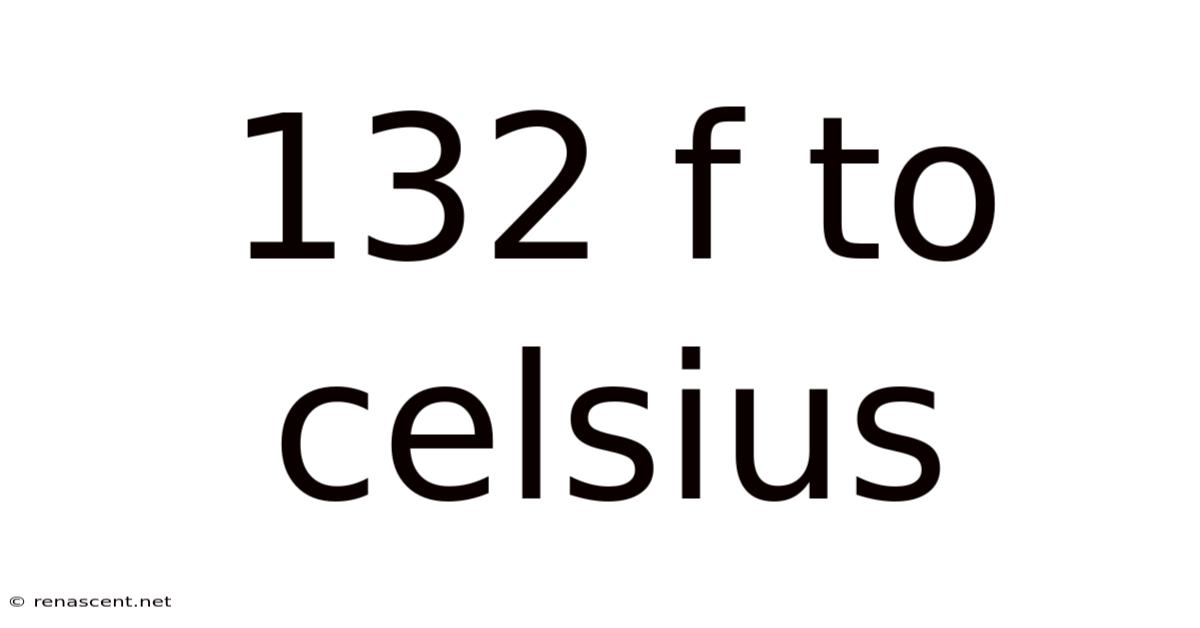132 F To Celsius
renascent
Sep 17, 2025 · 5 min read

Table of Contents
Decoding 132°F to Celsius: A Comprehensive Guide to Temperature Conversions
Converting Fahrenheit to Celsius is a common task, whether you're checking a weather report from a different country, adjusting an oven temperature, or understanding scientific data. This comprehensive guide will walk you through converting 132°F to Celsius, explain the underlying principles behind the conversion, and provide you with practical applications and further insights into temperature scales. We’ll also delve into frequently asked questions to ensure a thorough understanding of this essential conversion.
Understanding Fahrenheit and Celsius Scales
Before diving into the conversion of 132°F, let's briefly review the two temperature scales involved: Fahrenheit (°F) and Celsius (°C). Both are used to measure temperature, but they use different reference points.
-
Fahrenheit: This scale was developed by Daniel Gabriel Fahrenheit in the early 18th century. It sets the freezing point of water at 32°F and the boiling point at 212°F, with 180 degrees separating these two points.
-
Celsius: Also known as the centigrade scale, Celsius (°C) was developed by Anders Celsius in the mid-18th century. It defines the freezing point of water at 0°C and the boiling point at 100°C, with 100 degrees separating these points.
The difference in the scales lies in the size of their degrees and their zero points. A degree Celsius is larger than a degree Fahrenheit. This means a change of 1°C represents a larger temperature change than a change of 1°F.
Converting 132°F to Celsius: The Calculation
The formula for converting Fahrenheit (°F) to Celsius (°C) is:
°C = (°F - 32) × 5/9
Let's apply this formula to convert 132°F:
°C = (132 - 32) × 5/9
°C = 100 × 5/9
°C = 55.56 (approximately)
Therefore, 132°F is approximately equal to 55.56°C.
Step-by-Step Guide to Conversion
To make the conversion process clearer, let's break it down into simple steps:
-
Subtract 32 from the Fahrenheit temperature: 132°F - 32°F = 100°F. This step adjusts for the difference in the freezing points of the two scales.
-
Multiply the result by 5: 100°F × 5 = 500. This accounts for the different sizes of degrees in the two scales.
-
Divide the result by 9: 500 / 9 = 55.56 (approximately). This final step gives you the equivalent temperature in Celsius.
Practical Applications of Temperature Conversions
Understanding how to convert between Fahrenheit and Celsius is crucial in many situations:
-
International Travel: Many countries use the Celsius scale, so knowing how to convert temperatures will help you understand weather forecasts and adjust your clothing accordingly.
-
Cooking and Baking: Recipes often list temperatures in either Fahrenheit or Celsius. Being able to convert ensures you achieve the correct cooking results.
-
Science and Engineering: Scientific experiments and engineering projects often require precise temperature control, necessitating accurate conversions between scales.
-
Medical Applications: Body temperature readings can be given in either Fahrenheit or Celsius, requiring conversion for accurate interpretation.
-
Understanding Climate Data: Analyzing climate data from various sources requires converting temperatures to a consistent scale for accurate comparison and analysis.
A Deeper Dive into Temperature Scales: Absolute Zero
While Fahrenheit and Celsius are commonly used, another crucial temperature scale is the Kelvin (K) scale. This scale is an absolute temperature scale, meaning it starts at absolute zero, the theoretical point where all molecular motion ceases. Absolute zero is approximately -273.15°C or -459.67°F.
The Kelvin scale is used extensively in scientific applications because its absolute nature simplifies many thermodynamic calculations. The conversion from Celsius to Kelvin is straightforward:
K = °C + 273.15
Therefore, 55.56°C is equivalent to approximately 328.71 K.
Frequently Asked Questions (FAQ)
-
Why are there two different temperature scales? Historically, different scales evolved independently, with Fahrenheit gaining popularity in some regions and Celsius in others. The continued use of both reflects historical inertia and regional preferences.
-
Is there a simple way to approximate the conversion? A rough approximation is to subtract 30 from the Fahrenheit temperature and then divide by 2 to get an approximate Celsius value. However, this method is less precise than using the formal conversion formula.
-
Why is the conversion formula (°F - 32) × 5/9? This formula directly accounts for the difference in the freezing and boiling points of water, as well as the different sizes of the degrees in the two scales.
-
Are there online converters available? Yes, many online calculators and websites provide instant conversions between Fahrenheit and Celsius, offering a quick and convenient alternative to manual calculation. However, understanding the underlying principles remains valuable.
-
What is the significance of 132°F? 132°F (55.56°C) is a temperature typically considered warm to hot, depending on the context. It might represent a warm summer day or a high temperature in a cooking environment.
Conclusion: Mastering Temperature Conversions
Understanding temperature conversions is a fundamental skill with broad applications across various fields. The conversion of 132°F to approximately 55.56°C, as detailed in this guide, showcases the straightforward application of the conversion formula. However, understanding the underlying principles of the Fahrenheit and Celsius scales, and their relationship to the absolute Kelvin scale, provides a more profound appreciation of temperature measurement. By mastering these concepts, you'll be equipped to confidently navigate temperature conversions in any situation and appreciate the diverse ways temperature is measured and utilized across various scientific disciplines and everyday life. Remember to practice these conversions to build your confidence and fluency. The more you practice, the easier and more intuitive the process will become!
Latest Posts
Related Post
Thank you for visiting our website which covers about 132 F To Celsius . We hope the information provided has been useful to you. Feel free to contact us if you have any questions or need further assistance. See you next time and don't miss to bookmark.